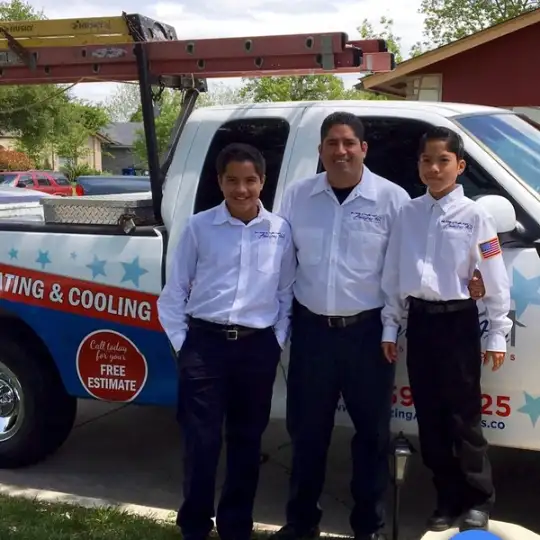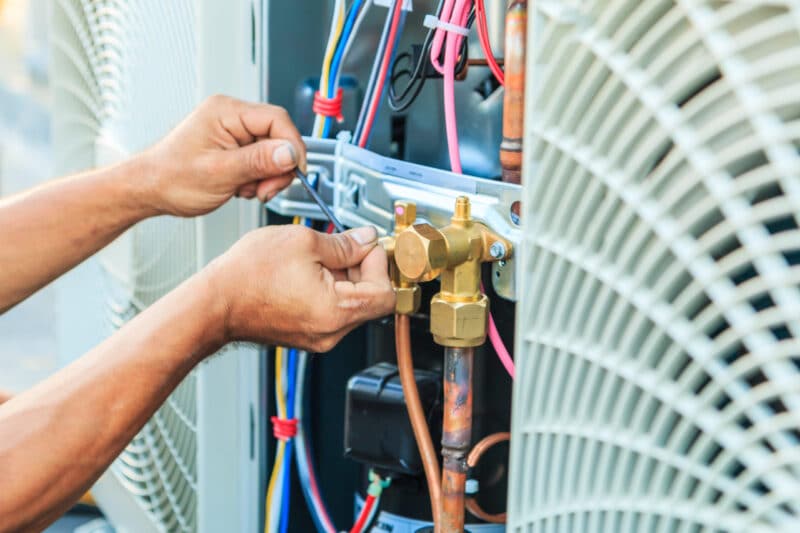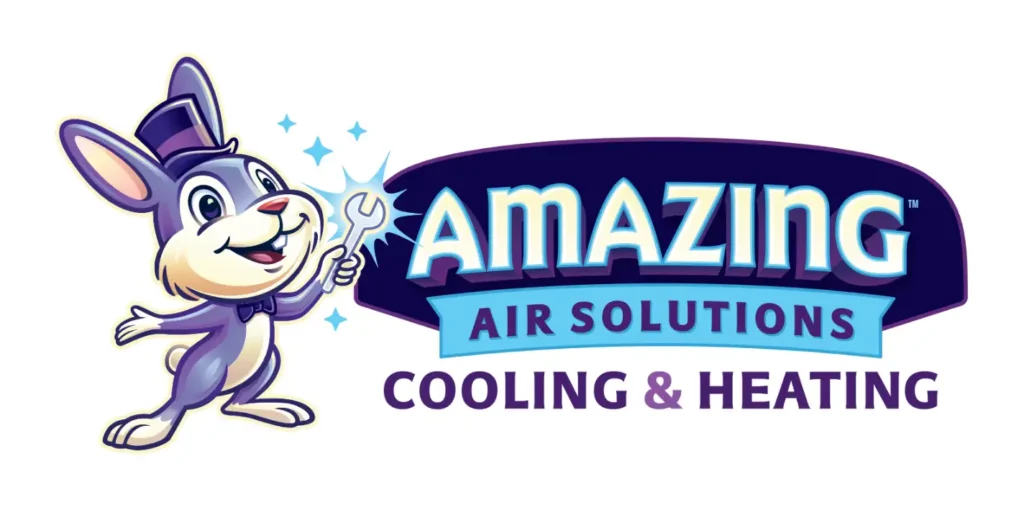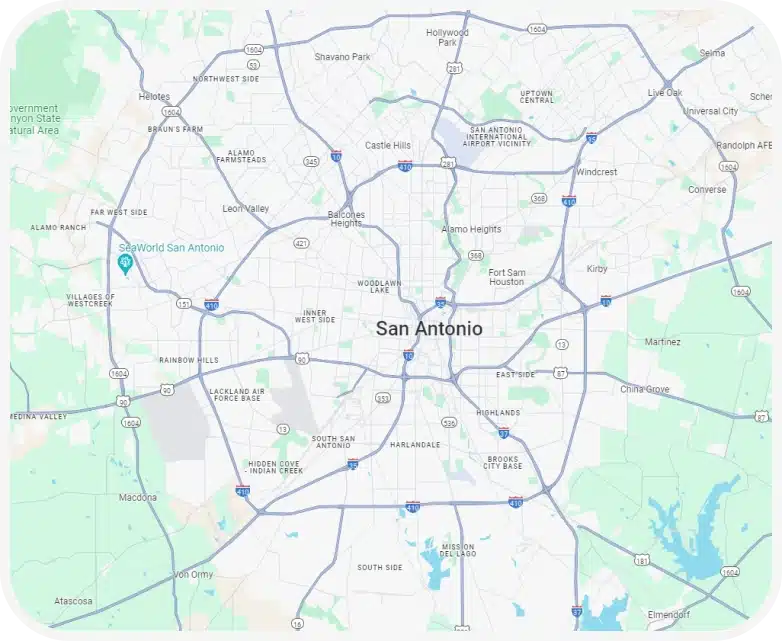
Need a reliable San Antonio AC and heating company to handle your cooling and heating needs? Reach out Amazing Air Solutions’s skilled team today and see why we’re one of the most trusted names in the area for exceptional service!
What you get from Amazing Air Solutions:
Don't wait until your A/C goes out on a hot summer day! Call us today to schedule your maintenance appointment
Providing routine maintenance on your cooling unit is essential for keeping your system running efficiently, extending its lifespan, and ensuring your home stays cool and comfortable. It’s a proactive measure that can save you money, improve indoor air quality, and reduce the likelihood of unexpected breakdowns.
Getting regular maintenance for your air conditioning (A/C) system is important for several reasons including:
Regular maintenance helps ensure that your A/C system operates at its peak efficiency. When your A/C is running efficiently, it consumes less energy, which can lead to lower utility bills.
Air conditioning maintenance can prolong the life of your system. When your A/C is well-maintained, it’s less likely to experience major breakdowns or failures, which can save you money on costly repairs or premature replacements.
Routine maintenance helps keep your cooling system’s components clean and in good working condition. This ensures that your A/C can effectively cool your home, providing consistent comfort throughout the hot summer months.
A well-maintained A/C system can help improve indoor air quality by removing dust, pollen, and other allergens from the air. Clean filters and coils prevent these particles from being circulated throughout your home.
Regular maintenance can catch minor issues before they escalate into major problems. This can save you money on unexpected and costly A/C repairs.
Maintenance appointments often involve inspections to identify potential issues early. Technicians can recommend necessary repairs or adjustments to prevent breakdowns during the peak cooling season.
Some A/C manufacturers require regular maintenance to keep your warranty valid. Skipping maintenance may void your warranty, leaving you responsible for any repair or replacement costs.
A well-maintained cooling unit operates quietly and reliably, providing you with consistent comfort and peace of mind.
Central AC systems provide consistent cooling throughout your home, eliminating hot spots or uneven cooling that can occur with window units.
An efficient A/C system consumes less energy, which reduces your carbon footprint and helps protect the environment.
While A/C maintenance does come with a cost, the potential savings in energy bills, repairs, and replacements over time can outweigh the initial investment.

No matter the situation, our Universal City, TX professional HVAC technicians will work to determine the best plan of action for installing a new air conditioning system in your home or business. From there, we will review the recommendations with you in detail, so you will know exactly what solution is best for your cooling needs before any work is done.
Amazing Air Solutions offers a full line of installation, maintenance, and repair that your cooling system may require. You can count on our trusted professionals for exceptional service and quality craftsmanship. Amazing Air Solutions is proudly and professionally serving the greater Universal City, TX area.

Air conditioning system maintenance is essential to ensure your unit operates efficiently, extends its lifespan, maintains indoor air quality, and reduces energy consumption.
It’s recommended to have your cooling system serviced at least once a year, preferably in the spring before the cooling season begins.
While there are some maintenance tasks you can do, like changing the air filter, it’s generally advisable to have a professional technician perform a comprehensive maintenance check to avoid potential problems and to ensure peace of mind.
A/C maintenance typically includes cleaning the coils, checking refrigerant levels, inspecting electrical components, lubricating moving parts, tightening connections, and calibrating thermostats.
Common signs include reduced cooling efficiency, strange noises, unusual odors, frequent cycling, and increased energy bills.
You can improve A/C efficiency by keeping your system’s air filter clean, sealing duct leaks, maintaining proper insulation, and using a programmable thermostat.
Call Us Today! (210) 538-7228

Maintaining your HVAC system is essential to ensure efficient performance and prevent costly repairs. When problems arise, identifying the root cause can feel overwhelming. This guide provides a step-by-step approach to diagnosing common issues with your heating, ventilation, and air conditioning (HVAC) system.
If adjusting these settings doesn’t resolve the issue, there could be integration issues between the thermostat and HVAC unit.
A clean filter not only supports airflow but also reduces strain on internal components.
Filter Type | Replacement Frequency |
Fiberglass | Monthly |
Pleated | Every 2–3 months |
HEPA | Every 6–12 months |
If visual inspection shows bent fins, use a fin comb to straighten them carefully.
Issue | Likely Cause | Action Required |
Weak airflow | Clogged filter | Replace filter |
Warm air during cooling | Low refrigerant levels | Contact professional |
System short cycling | Thermostat miscalibration; dirty coils | Adjust settings; schedule cleaning |
High energy usage | Dirty components; poor insulation | Clean unit; inspect home insulation |
Regularly reviewing these aspects ensures that small problems don’t escalate into expensive repairs over time while improving overall comfort at home.
An HVAC system is essential for maintaining indoor comfort, but like any mechanical system, it can develop issues over time. By understanding the most common problems and their associated symptoms, homeowners can address minor concerns before they escalate into expensive repairs. Below are some frequent HVAC problems and how you can recognize them.
Symptoms to watch for:
– Weak or uneven airflow throughout your home
– Increased energy bills due to an overworked system
Symptoms to watch for:
– Hot and cold spots in rooms
– Difficulty reaching the desired temperature on your thermostat
Refrigerant is crucial for cooling in an HVAC system. A leak not only reduces efficiency but may also cause long-term damage if left untreated.
Symptoms to watch for:
– Warm air blowing from vents when set to cool mode
– Ice forming on refrigerant lines or the outdoor unit’s evaporator coil
– Hissing sounds near refrigerant lines
Symptom | Possible Cause |
Warm air from vents | Refrigerant leak |
Ice on coils | Low refrigerant levels |
Hissing noise | Damaged refrigerant line |
Symptoms to watch for:
Pay attention when new noises develop during regular operation as they often escalate without maintenance intervention.
Short cycling occurs if equipment fails repeatedly fails restarting normal operational states requiring troubleshooting reasons involving..
Taking care of your HVAC system requires understanding the typical issues that may arise and knowing how to recognize their symptoms. Early identification of these problems can help you address them efficiently, reduce repair costs, and extend the lifespan of your heating and cooling units. Below are some of the most common HVAC problems and their associated warning signs.
One of the most frequently observed issues with HVAC systems is poor airflow. This problem can lead to discomfort and reduced system efficiency.
Symptoms: – Weak or limited air coming from vents – Hot or cold spots in different areas of your home – Increased energy bills despite regular usage
Potential Causes: – Clogged air filters – Blocked or leaky ductwork – Malfunctioning blower motor
Solution: Regularly clean or replace air filters, inspect ductwork for obstructions, and schedule routine maintenance to ensure proper airflow.
Refrigerant is essential for cooling your home. A leak not only reduces system performance but can also harm the environment if not addressed promptly.
Symptoms: – Warm air blowing from vents while in cooling mode – Hissing or bubbling noises near refrigerant lines – Ice buildup on outdoor coils
Potential Causes: – Damaged refrigerant lines – Loose connections – Wear-and-tear over time
Solution: Contact a licensed technician to locate and fix leaks, then recharge the refrigerant to recommended levels.
Your thermostat regulates indoor temperature by communicating with the HVAC system. A malfunctioning thermostat disrupts this process.
Symptoms: – Inconsistent temperature readings – The system fails to turn on/off as scheduled – Unresponsive controls on digital thermostats
Potential Causes: – Incorrect calibration – Dead batteries (for battery-operated models) – Outdated or faulty thermostat hardware
Solution: Replace batteries regularly, recalibrate when needed, or upgrade to a programmable smart thermostat for better control.
Unusual sounds coming from your HVAC unit often indicate underlying mechanical issues that require prompt attention.
Noise Type | Potential Issue |
Squealing | Worn-out belts |
Grinding | Motor or bearing problems |
Rattling | Loose components |
Banging | Blower assembly imbalance |
Addressing these noises early can help avoid costly repairs down the line.
Short cycling occurs when an HVAC system turns on and off repeatedly without completing full heating or cooling cycles.
Symptoms: – System runs for very short periods before shutting off – Uneven indoor temperatures
Potential Causes: – Oversized unit for your home’s needs
– Dirty evaporator coils affecting cooling performance
– Electrical issues disrupting normal operation
Solution:
Have an expert evaluate whether your unit is correctly sized for your space, clean components like coils regularly, and inspect electrical connections as needed.
Addressing common HVAC issues promptly can improve energy efficiency, comfort, and overall system functionality while minimizing unexpected breakdowns. Preventive care like routine inspections coupled with attention to warning signs ensures reliable operation throughout every season.
Proper inspection and maintenance of key HVAC components are fundamental to ensuring the efficiency and longevity of your heating, ventilation, and air conditioning system. Neglected systems can lead to poor indoor air quality, increased energy bills, and unexpected breakdowns. Below is a guide on how to inspect and maintain critical parts like air filters and outdoor units in a professional manner.
The outdoor unit (condenser or heat pump) is critical for both heating and cooling functions in your HVAC system. It requires periodic care to ensure optimal performance.
Regular attention toward these key parts ensures your HVAC system runs efficiently while minimizing energy costs—a small investment today prevents significant expenses down the road.
When working with heating, ventilation, and air conditioning (HVAC) systems, safety is a top priority. These systems involve electricity, refrigerants, gas connections, and mechanical components that can pose serious risks if improperly handled. Here are the key safety concerns to be aware of and how to address them effectively.
Many HVAC systems rely on natural gas or propane for heating. Improper handling can lead to dangerous leaks.
Signs of Carbon Monoxide Issues | Action Required |
Yellow burner flames (instead of blue) | Schedule professional servicing |
Soot buildup around vents | Check venting systems immediately |
Frequent headaches when indoors | Test indoor air quality |
Refrigerants are essential in cooling systems but require proper care due to their chemical properties.
By understanding these key safety concerns and taking appropriate measures, you reduce risks significantly while maintaining efficiency in your HVAC system’s performance.
When your HVAC system starts acting up, it’s not always necessary to jump straight to replacement. Sometimes, simple troubleshooting steps can resolve the issue and save you significant time and money. Below is a guide to help identify and address common HVAC problems before deciding on a costly replacement.
The thermostat is often overlooked during troubleshooting but plays a crucial role in your system’s functionality.
Dirty or clogged air filters can significantly impact airflow and system efficiency. A quick check can determine if they need replacing.
Filter Type | Replacement Frequency |
Standard fiberglass | Every month |
Pleated filters | Every 90 days |
HEPA filters | As recommended by manufacturer |
If these basic steps do not resolve your HVAC issues, it may be time to consult with an HVAC technician. Professionals have specialized tools and expertise to diagnose complex problems such as refrigerant leaks, faulty compressors, or damaged heat exchangers.
Regular maintenance paired with these troubleshooting tips can extend your system’s life while ensuring it operates efficiently throughout its lifespan.
Copyright © 2025 Amazing Air Solutions. Camp Digital – All Rights Reserved. Privacy Policy.